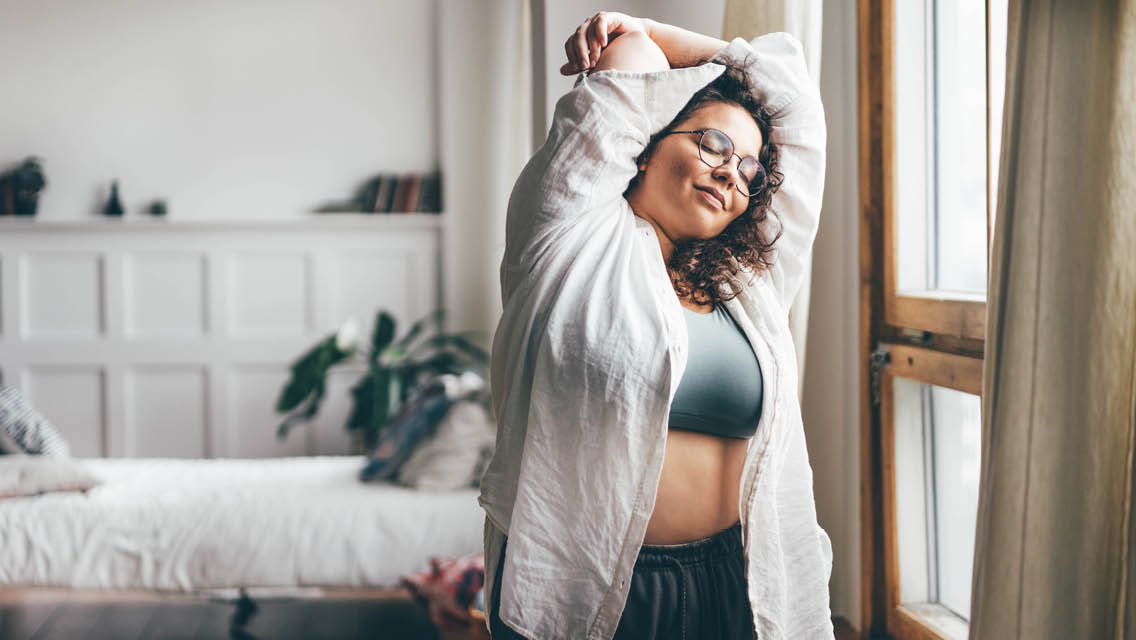When Diane Sepanski looks in the mirror, she loves what she sees: a short and stocky 41-year-old with curly Sarah Jessica Parker locks, blue-gray eyes, her dad’s prominent nose, sturdy thighs, a big butt, and some nice cleavage. Says Sepanski: “I’m beginning to look like my beautiful Polish peasant grandmother.”
She wasn’t always so at home in her skin. Now a writer and editor in Seattle, Sepanski grew up hyper-aware of everything she didn’t love about her body. Her small-boned, 5-foot-3-inch frame made her feel insignificant and overlooked. She was keenly aware of how blouses draped limply on her shoulders; how even strangers commented that she’d one day hit a growth spurt; how she literally didn’t measure up to the other girls around her.
Years later, Sepanski is quick to say she hasn’t figured out some magic escape hatch from commercial and sexual body-image pressures. What she has learned — through a very personal process of self-reflection and writing, including an essay in the anthology Body Outlaws — is that you have to nurture your relationship with your body just as you would nurture any intimate relationship.
“That’s an ongoing process,” she says, “one that I work at every day, whether it’s through going to the gym when I don’t feel like it, or doing yoga, or going to therapy, or just cooking myself a big, lusty, generous meal!” The results have been profound: Sepanski sees aging, and the physical changes that accompany it, as an evolution full of opportunities for learning and self-appreciation.
If you’re ready to explore those opportunities, here are some smart suggestions to help you live in the body you love, and to love the body you’re in.
Look in the Mirror
Answer honestly: When was the last time you looked in the mirror? Not just a quick check of hair or teeth, but really looked? According to a study from the Journal of Rational-Emotive & Cognitive-Behavior Therapy, mirror exposure therapy can significantly boost body esteem.
It’s best to use a full-length mirror, explains Sabine Wilhelm, PhD, director of the Body Dysmorphic Disorder Clinic and Research Unit at Massachusetts General Hospital in Boston.
First, take a good, long look at your body, resisting the urge to zero-in on body parts you dislike. Try to ignore your perceptions of fat, skinny, beautiful and ugly.
Erase all the body-related chatter from your mind. Just look at your body and try to see it simply and honestly. When you feel ready, state out loud at least five nonjudgmental things about yourself. (If you have trouble getting started, simply saying “My hair is brown” works.)
Then, without skipping or dwelling on any particular body part, describe — objectively and out loud — how you look. Use color, texture, proportion, shape and symmetry, but not subjective words like “gross” or “too big.” (“I have a heart-shaped face that is slightly red across the nose and cheeks.”)
If you feel ready, state five things about your appearance that you like, and what you like about them.
“It does feel a little bit strange at the beginning,” says Wilhelm. “But once you get into it, it feels kind of like a conversation you’re having with yourself, and it starts to become quite nice. Like anything, it’s a habit you have to develop over time. It’s about learning to train yourself to see your body as it is, rather than immediately focusing on what you don’t like.”
Balance Your Media Diet
Mass media can be influential, even for those who seem to be impervious to its messages. Feminist icon Betty Friedan, author of The Feminine Mystique, bleached her dark locks golden in 1962 because she was entranced by a Clairol ad: “If I’ve only one life, let me live it as a blonde!”
Becoming conscious of the impact that idealized media images have on your self-perception isn’t just an exercise in liberation, say experts, it’s an act of self-preservation. A meta-analysis of 77 separate correlational and experimental studies, published in a May 2008 volume of the American Psychological Association’s Psychological Bulletin, found that “body dissatisfaction has emerged as a core aspect of women’s physical and mental health.”
This is true for men and boys, as well. A recent study, published in the Journal of Social and Clinical Psychology, found that “the relationship between exposure to the mass media and negative self-images in males is consistent across the literature.”
Blocking the destructive effects of media isn’t easy. By some estimates, Americans see more than 3,000 ads daily. But it is possible to cultivate an internal censor. Caroline Ticarro-Parker, executive director of Mind on the Media, a Northfield, Minn., media-reform organization, has made it a priority to cultivate this skill. “When I’m watching TV or flipping through a magazine, or even walking down the street, I have this kind of inner dialogue running,” Ticarro-Parker says. “I’m thinking: OK, what is this ad really trying to sell? How many people of color are represented? How many older people? Is that woman realistic looking?”
Sepanski takes a different approach. She works to surround herself with different images, different bodies and different faces, to reinforce a big truth: Beauty is infinite. “Think about it,” she says. “Do we love only one type of flower, or one flavor of ice cream, or one color, or one song? No. We have many moods, many shadings, varied tastes.”
Pivot Your Perspective
According to a study published in the March 2008 issue of the American Journal of Public Health, the desire to lose weight is a strong predictor of chronic disease. Stressing about weight can cause the body to release stress chemicals, which contribute to hypertension, heart disease, type 2 diabetes and hypercholesterolemia.
The desire to lose weight is a strong predictor of chronic disease.
Instead of crash dieting or self-loathing, try this: Treat your body as though it were a good friend. That means feeding it well, giving it the exercise it needs, keeping it away from harmful chemicals and appreciating it for what it provides: a lap for children, hands to play the piano or 10,000 taste buds to savor that heirloom tomato.
“You’ll always have good days and bad days, and through the years, things change,” says Sepanski. But if you practice this more positive and loving perspective, you may just find yourself with a new, lifelong friend — your own body.
Self-Talk That Sustains
Instead of bemoaning perceived imperfections, make it a goal to say and think positive things about your body. You’ll be amazed at the difference it makes.
If you: Habitually make general disses, such as, “I hate my legs!” or “Ugh, I’m so out of shape.”
Try this: Catch yourself in the act and either reframe the comment with constructive intent (“I’m going to get out for a hike!”) or don’t say anything at all, and just take note of the voices in your mind. Caroline Ticarro-Parker, executive director of Mind on the Media, wanted to set a good example for her daughters, so she made a pact with herself not to make negative comments about her body. “Now, after more than 10 years, they don’t even come into my head,” she says.
If you: Make negative comparisons, such as, “Yeah, I’ve slimmed down a little, but I’m still no super model.”
Try this: Revel in what you’re pleased about, instead: Say, “I’m glad I’ve been eating healthy lately, and my energy is good.” Leave comparisons out of the equation. You’ve got one body — appreciate it for all it is.
If you: Reject compliments (“Nice feet? Ugh, I hate my feet!” or “Really? I think these pants make me look fat.”)
Try this: Accept compliments with a smile. “Our instinct is to negate ourselves,” says Ticarro-Parker. “But the best answer is just a simple ‘thank you.’”
Any shift in habitual behavior presents challenges and may seem awkward at first, but the more you make self-respecting adjustments, the more automatic they become.
Yet if any of these suggestions seem really out of reach for you, or if you encounter deeper emotional issues in attempting them, consider talking with a therapist who specializes in body-image issues. Self-image problems, such as compulsive self-criticism or body dysmorphia, can lead to self-destructive, even life-threatening behaviors and should be evaluated by a professional.
This article originally appeared as “Body Positive” in the December 2008 issue of Experience Life.




This Post Has 0 Comments